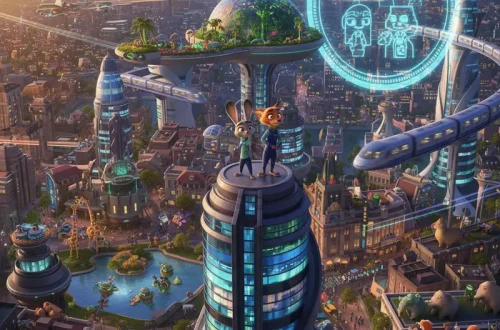
WALL-E, the heartwarming Pixar sci-fi romance film that takes viewers on a journey to the year 2805, is known for its extraordinary storytelling. It introduces us to the titular robot, WALL-E, who diligently goes about his daily tasks of cleaning up a deserted Earth. In this post-apocalyptic world, humanity has taken refuge in space aboard the giant starliner Axiom, eagerly awaiting the day when they can return to their once-polluted planet, now clean and habitable.
One of the most remarkable aspects of WALL-E is its character-driven narrative, which is a rarity in the world of animation. The film’s ability to convey deep emotions without relying on dialogue is a testament to its exceptional storytelling. WALL-E’s character is so endearing that he communicates through his actions, expressions, and movements. As he goes about his work and interacts with his pet cockroach, he carries a sense of loneliness and yearning for something more. This lack of dialogue from the film’s central character is a bold narrative choice, but it is a risk that WALL-E takes with great success.
The film’s unique approach to storytelling sets it apart and makes it one of the standout works in the Pixar canon. WALL-E’s ability to convey a complex range of emotions through animation alone is a testament to the power of the medium. His curiosity, longing, and love for classic movies like “Hello Dolly!” are all skillfully portrayed without a single word spoken. It’s this emotional depth that elevates WALL-E to a level that transcends traditional animation.

Furthermore, WALL-E’s message about environmental conservation and the consequences of climate change resonated strongly with audiences. The film masterfully weaves this theme into its narrative, delivering a poignant message without the need for lengthy exposition or dialogue. In a time when environmental issues are of global concern, WALL-E’s approach to storytelling is not only innovative but also socially relevant.
It’s worth noting that Pixar’s decision to have a dialogue-less protagonist is not unprecedented in the world of animation. Disney’s 1941 classic, “Dumbo,” also took a similar risk. “Dumbo” tells the story of a young elephant ridiculed for his oversized ears but eventually wins the circus’s affection when he reveals his unique ability to fly. Just like WALL-E, Dumbo’s character does not engage in dialogue throughout the film.
In both “WALL-E” and “Dumbo,” the absence of dialogue from the central characters is a daring narrative choice that could have potentially disconnected viewers from the protagonists and the overall narrative. However, both films triumph over this challenge through their exceptional animation, the nuanced expressions of their characters, and the ability to convey a wide range of emotions. It is through their visual storytelling, combined with memorable scores and captivating narratives, that these films prove the immense power of animation as a cinematic medium.

In the end, WALL-E’s decision to go dialogue-less is not just a storytelling risk; it’s a testament to the creative courage and brilliance of the team at Pixar. This risk paid off handsomely, as the film not only became a critical and commercial success but also won the Oscar for Best Animated Film in 2008. WALL-E stands as a shining example of how animation can deliver powerful, emotionally resonant narratives and engage audiences on a profound level, making it one of Pixar’s most iconic and beloved creations.
We bring out some of the most well-known Disney collection, all of which are available at reasonable costs. Visit our link now if you are interested in the Disney collection


Peter Pan, Wendy Darling, Tinker Bell, Captain Hook, Simba
